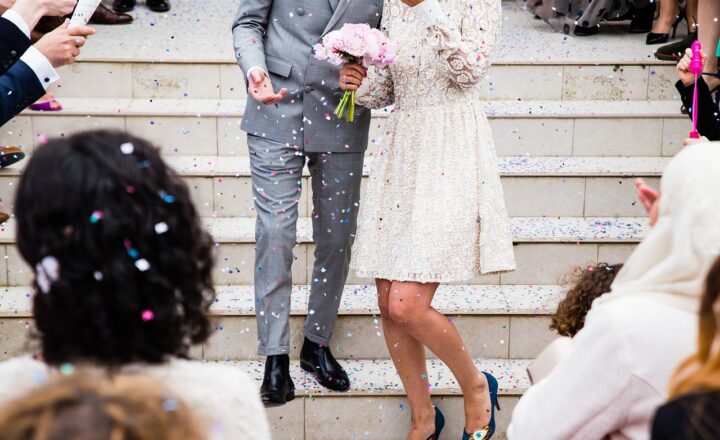The Evolution of Weddings from Traditions to Modern Celebrations
November 15, 2024

Weddings have long been a significant cultural event, steeped in a rich tapestry of traditions and expectations. However, what was once a ceremony defined by painstaking rituals and customs has gradually transformed into a diverse and personalized celebration. From the stock weddings of our ancestors to the extravagant ceremonies of today, the evolution of weddings reflects broader societal changes, shifting values, and a growing emphasis on individuality.
1. Ancient Weddings: The Foundations of Tradition
Historically, weddings were often arranged for economic or political reasons rather than romantic love. In ancient civilizations, such as those in Egypt, Greece, and Rome, marriages were transactional, often solidifying alliances and families rather than celebrating personal unions. For instance, the ancient Egyptians conducted elaborate rituals to ensure blessings from the gods, while Romans exchanged tokens, known as “rings,” symbolizing commitment.
Within many cultures, a dowry or bride price was common, emphasizing the economic aspect of marriage. In some cases, severe contractual obligations tied families together, making divorce nearly impossible. Religious influences also played a significant role, marking the transition from secular to spiritual ceremonies.
Despite the transactional nature of these ancient weddings, some traditions have surprisingly endured. For instance, the ceremonial exchange of rings symbolizes commitment in many cultures, a practice still prevalent today.
2. Middle Ages: The Rise of Romantic Marriages
During the Middle Ages, the notion of love began to permeate the institution of marriage. While many marriages were still arranged, the rise of courtly love literature began to paint romance as a paramount consideration. Marriages incorporated more personal touch, and the use of romantic symbols such as flowers and rings became popular.
Religious institutions also gained greater control over marriage ceremonies, transforming weddings into sacred rites. Many couples sought the blessings of the clergy in churches which also influenced the kinds of vows exchanged.
Weddings became community events, often attended by extended family and friends, blurring the lines between personal and social celebrations. Customs like reciting marriage vows and using wedding rings were solidified during this period, continuing to shape the modern wedding ceremony.
3. The Renaissance to the 19th Century: A Flourishing of Traditions
The Renaissance witnessed a resurgence of art, culture, and individuality, culminating in lavish weddings among the upper classes. Newly emerging wealth fostered opulent celebrations characterized by elaborate venues, sumptuous meals, and ornamental attire.
However, beneath the grandeur, weddings were often still entrenched in practice regarding family alliances and social status. The 19th century further entwined weddings and marketing when businesses began to capitalize on wedding planning services, bridal fashion, and the burgeoning publishing of bridal magazines.
This era also popularized the idea of the white wedding dress, made famous by Queen Victoria in 1840. This symbol of purity and status still echoes in modern wedding planning as brides around the globe adopt and maintain this tradition.
4. 20th Century: The Shift Toward Individual Expression
The 20th century marked a turning point in wedding etiquette, introducing concepts of individualism and self-expression. Post-World War II, the concept of marrying for love gained traction, shifting the focus away from economic necessity toward emotional fulfillment. Couples began to take charge of their wedding styles, often creating personalized celebrations that reflected their unique values.
With the rise of popular culture and celebrity influence, engagement rings became essential, leading to a resurgence in diamond ring advertisements, forever linking engagement to extravagant promises of love.
As society moved toward equality, more couples challenged traditional gender roles in weddings, prompting changes in how weddings were planned and celebrated. The introduction of same-sex marriage in many parts of the world further revolutionized the landscape, leading to a broader array of wedding types and expressions.
5. Modern Weddings: A Reflection of Society
Today, weddings are as varied as the couples celebrating them, blending traditions from multiple cultures and personal values into unique ceremonies. There are many different approaches to wedding planning—themed weddings, micro-weddings, elopements, and eco-friendly options, including more inclusive practices that resonate with contemporary values.
Social media, especially platforms like Instagram, has further influenced wedding trends, with couples exploring and showcasing their big day’s aesthetics, tailored décor, and overall experience. This modern twist on wedding planning allows brides and grooms to draw inspiration from countless sources and incorporate personal stories into their ceremonies.
Moreover, there’s an increasing focus on the environment with couples seeking sustainable options, favoring local vendors, and embracing eco-conscious decor choices. Technology also plays a vital role, with some couples opting for live-streaming or creating websites dedicated to their weddings, highlighting the blend of traditional and modern elements.
6. Conclusion: Celebrating Diversity and Individuality
As weddings evolve, they increasingly reflect societal norms, expectations, and the individual personalities of couples. The beautiful tapestry of traditions and innovations woven throughout history continues to enrich modern wedding celebrations today. While certain customs may remain, the truth is that as we move forward, weddings will continue to adapt alongside the ever-changing values of society.
Whether emphasizing cultural heritage or showcasing unique love stories, today’s weddings are a joyous celebration of love—one that embodies personal choice, diversity, and community spirit. Couples are no longer bound by historical conventions but are free to define their own ceremonies, creating lasting memories that resonate deeply across generations.
In conclusion, the evolution of weddings invites us not only to appreciate the journey these celebrations have taken but also to embrace the diversity and individuality they now represent. This amalgamation of past traditions and contemporary practices enriches our understanding of love and commitment, ensuring that weddings remain meaningful milestones in people’s lives for years to come.






